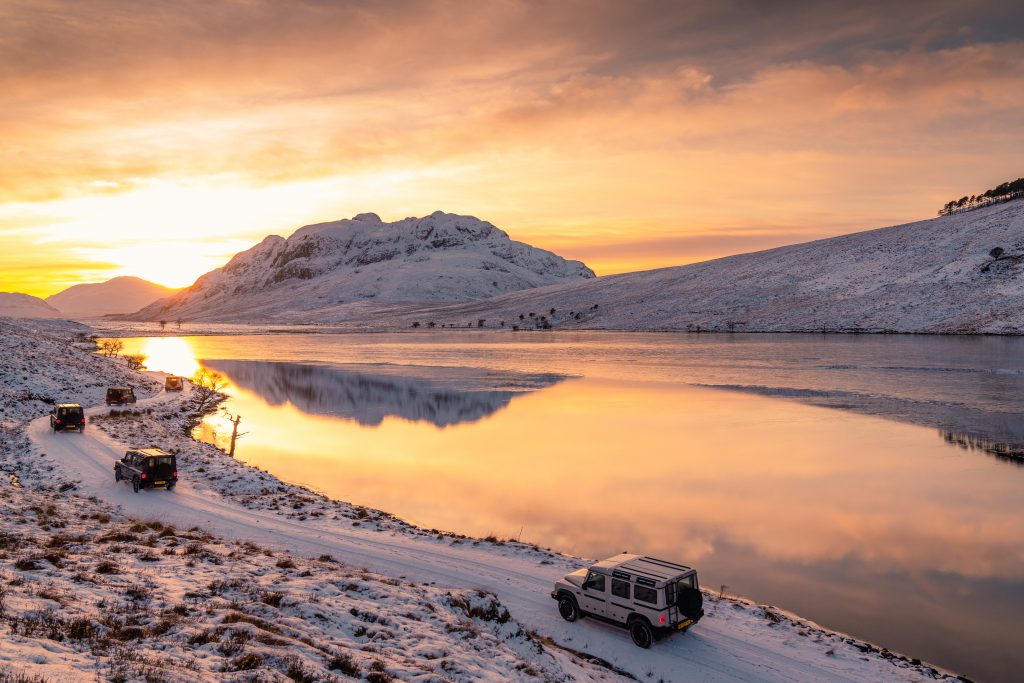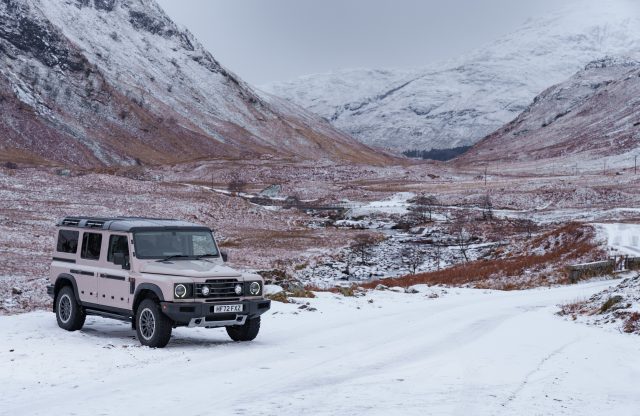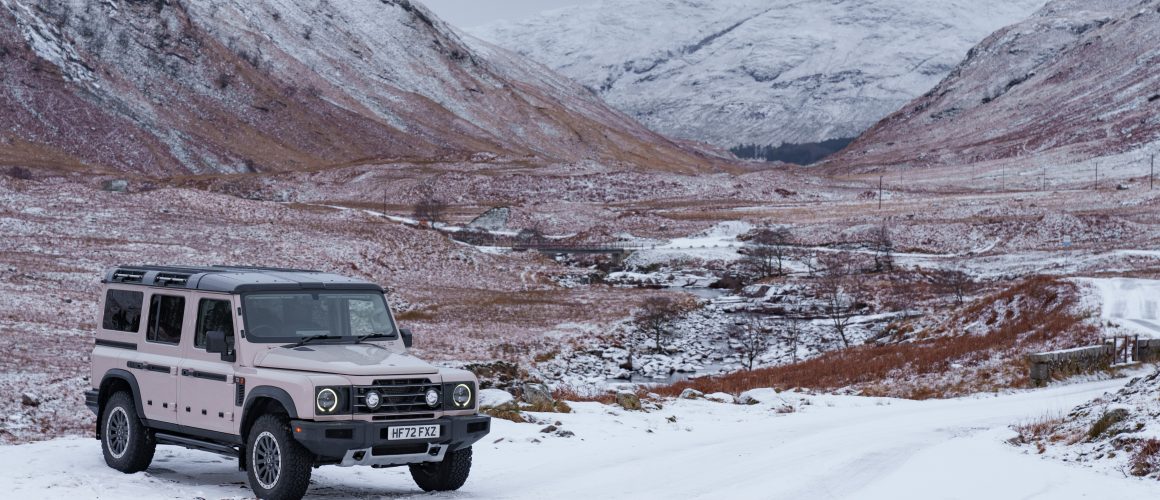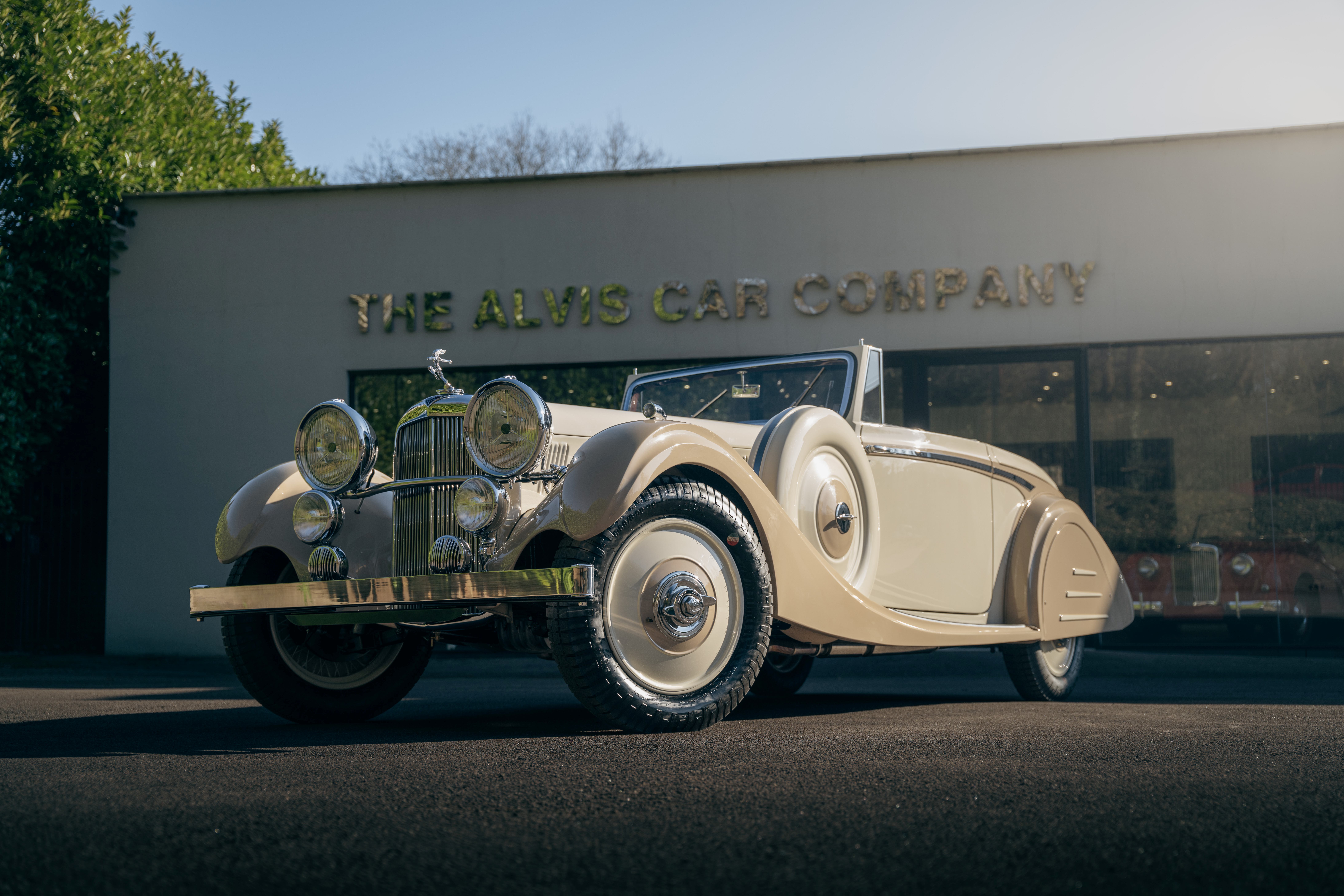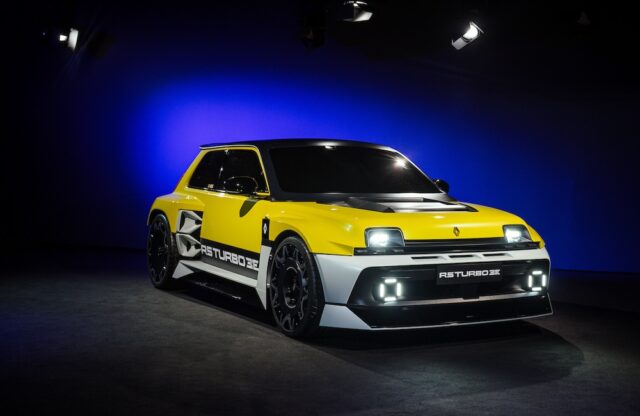WORDS: ELLIOTT HUGHES | PHOTOS: INEOS
The original Land Rover Defender, although deeply flawed, was always going to be a hard act to follow. And, predictably, plenty of fans were aghast when Land Rover replaced its most iconic model with a more plush, upmarket and complicated successor in 2020.
Enter stage right: the founder, chairman and CEO of INEOS, Sir Jim Ratcliffe. A self-made billionaire and adventurer, Sir Jim was among those bereft about the Defender’s discontinuation. Unlike the vast majority, however, he had both the means and the will to do something about it.
So, in July 2016, Ratcliffe attempted to buy Defender tooling from Land Rover so that production could continue. Land Rover declined. Crestfallen, Sir Jim and a few friends convened in their Belgravia, London local and incredulously lamented the Defender’s demise. It was here that the lightbulb went on, and Sir Jim decided to build his own spiritual successor, which he named the Grenadier after the very pub in which the idea was conceived.

Six years, $1.6 billion and a lawsuit with Land Rover later, I am holding the keys to a production-spec Grenadier. I am about to embark on the second leg of the car’s global media launch, a multi-part adventure that sets off from the Castle of Mey near John O’Groats and fittingly ends in London at the Grenadier pub, which Sir Jim now owns.
The second leg runs from Inverness to Glasgow through the heart of the Scottish Highlands, via a predominantly off-road route. It’s 8am, still dark and the January air is bitingly cold. Flakes of snow cascade to the ground, blanketing the scenery around our group. Twelve production Grenadiers of various specifications are assembled at the start line, engines running, heaters on full blast.
Our troop of Grenadiers looks right at home in the snow. The Defender’s influence on the exterior styling is obvious, particularly in side profile, although there are also touches of Mercedes-Benz G-Wagen and Toyota Land Cruiser. The familiar styling belies what is an all-new bespoke design created with industry-leading expertise from the likes of Magna Steyr, Eibach, BMW, Carraro and ZF.
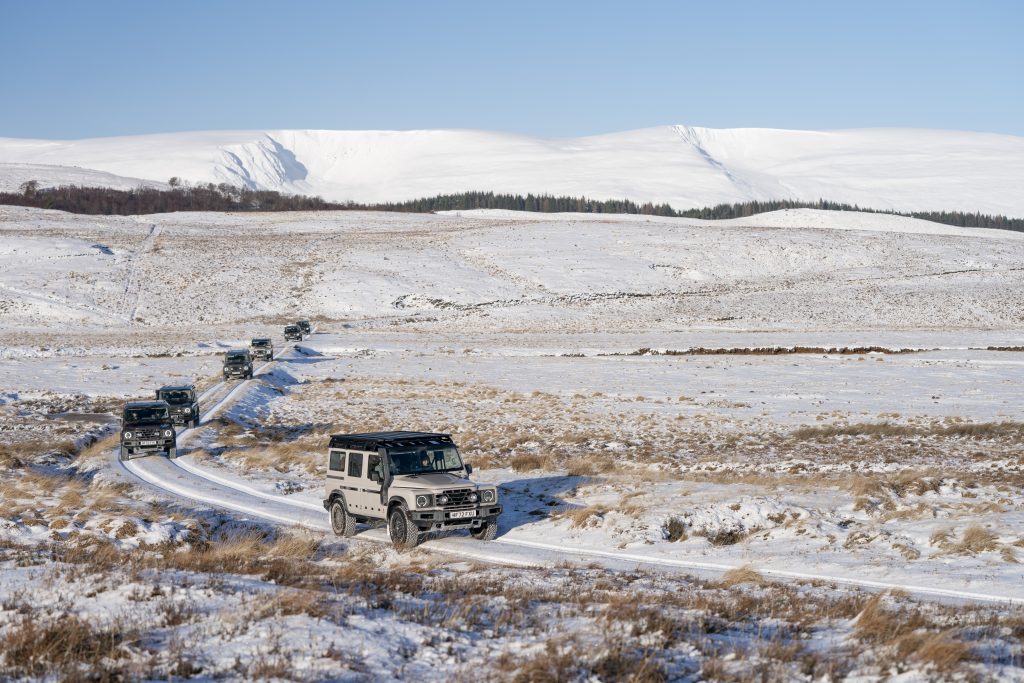
After reacquainting myself with the car’s exterior, I’m eager to retreat from the cold and into the warmth of the cabin. The Grenadier’s interior is far more distinct. The roof-mounted control panel is the biggest talking point, and it’s where you’ll find suitably chunky switches that enable off-road mode, engage hill-descent control and lock differentials. There are also several rows of pre-wired auxiliary switchgear that make it easy to add accessories such as spotlights, a winch or even a fridge.
The centre console is dominated by rows of modular switches that are easily replaceable with nothing more than a screwdriver. Above the switches, you’ll find a central display screen, and below that, a circular compass and altimeter. Space up front is decent, and the Recaro-supplied seats are both supportive and comfortable.
On the whole, it’s a great interior, and light years ahead of the old Defender’s – although it’s not perfect. The first example I try, a diesel Belstaff Trialmaster model, does not come equipped with heated seats, which feels a little miserly for a car that starts at £69,000. The roof-mounted control panel also isn’t as intuitive to operate as you might think, and dirt accumulates on the windows in such a way that it obstructs your view of the wing mirrors. Interior storage is also surprisingly meagre for such a big vehicle.

Our route begins with a near 70-mile drive down the A9 from Inverness towards the stunning Ardverikie Estate and Loch Laggan. My diesel model feels surprisingly quick for a 2.8-tonne off-roader, and certainly faster than INEOS’s claimed 0-62mph time of 9.9 seconds. The petrol version is even more sprightly, delivering 0-62mph in 8.6 seconds, but it’s also thirstier than the oil-burner. Both are limited to a 99mph top speed. The ZF-supplied eight-speed automatic transmission shifts smoothly and is great with either engine.
The ride quality is another welcome departure from what you might expect of such an off-road-focused car. The Grenadier is more stable and has a smoother ride than comparable vehicles underpinned by a ladder chassis and beam axles. The driving experience is further enhanced by perfectly adequate in-car speakers, while navigating the reskinned BMW i-Drive infotainment screen is straightforward.

Even so, it’s clear that concessions have been made in the name of off-road capability. The most obvious of these relates to the steering, which is slow, vague and doesn’t self-centre. The old-school set-up will feel familiar to anyone used to driving an old Defender, because the Grenadier also uses a durable recirculating-ball system. The combination of this steering box and tough ladder-chassis construction means you find yourself sawing at the wheel like an actor driving a Chevrolet in an 1950s film.
Off-roading in a INEOS is a refreshingly analogue experience. Our route starts on a narrow, craggy track glazed with ice and littered with jagged rocks and deep potholes. Permanent four-wheel drive and optional BFGoodrich All-Terrain tyres mean the Grenadier doesn’t break a sweat, resolutely clawing its way through mud and slush, and over rocks.
The route becomes more demanding as we get deeper into Ardverikie and make our way towards the banks of Loch Laggan. A steep, slippery slope already churned up by other cars in the convoy offers the first notable challenge.
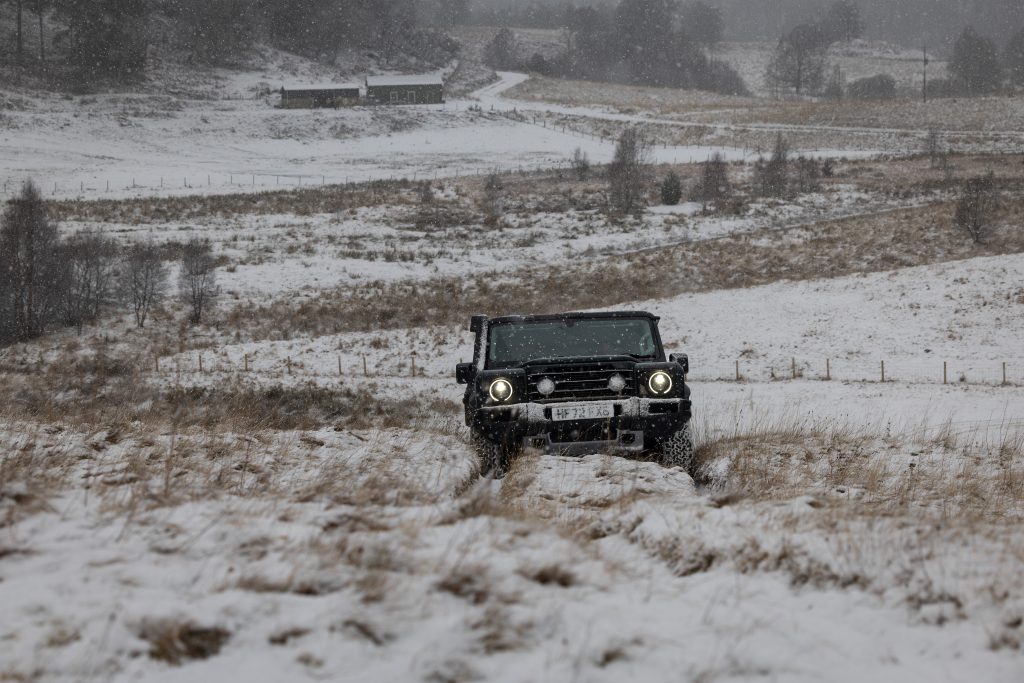
I’m instructed to flick the BMW gear selector into neutral, manhandle the transfer-case lever across its gate to select low range, and then lock the centre differential. It feels suitably burly. Then, lock the front and rear diffs with the roof switches, and wait for them to engage. Getting the Grenadier into the best off-road settings is a process that requires experience, and is rather more involved than selecting a terrain mode in a modern Land Rover.
Keep the two-spoke steering wheel dead straight, squeeze the accelerator pedal and the car begins its determined, muddy ascent to the summit. Tyres occasionally spin as the 4×4 searches for grip, but it continues to climb unabated as mud splatters the doors and windows.

Of course, what goes up must come down – so next I enable the hill-descent control and grimace as I tease the Grenadier’s grille over the summit. I even pluck up enough courage to remove my feet from the pedals and let the car’s systems take control of the descent. The snowy ground then fills the view through my windscreen as the INEOS crawls to the bottom of the muddy slope.
Next, we head to the banks of Loch Laggan to test the Grenadier’s paddling capabilities. I enable Wading Mode, for which the ECU disables the radiator fans to prevent water from being splashed into the intake. Water laps at the windows as a bow wave forms around that slab of a nose, and the INEOS chuggs through the loch, its wheels completely submerged. The way the Grenadier handles such challenging terrain is certainly impressive, let down only by the occasional reluctance of the front and rear diffs to engage and disengage.

As a spiritual successor to the Defender, the Grenadier is a triumphant debut from Sir Jim Ratcliffe’s new marque. It’s just as capable off-road as the departed Land Rover, yet considerably more modern and refined on Tarmac. As a tool, the INEOS is the perfect companion for those who work in the great outdoors, and it is in rarefied company as one of the last analogue, no-nonsense off-road vehicles. However, with prices starting at £55,000 for a basic two-seat utility model and £69,000 for one of the top-of-the-line Belstaff edition range-toppers, the Grenadier is right in the firing line of the new Defender.
